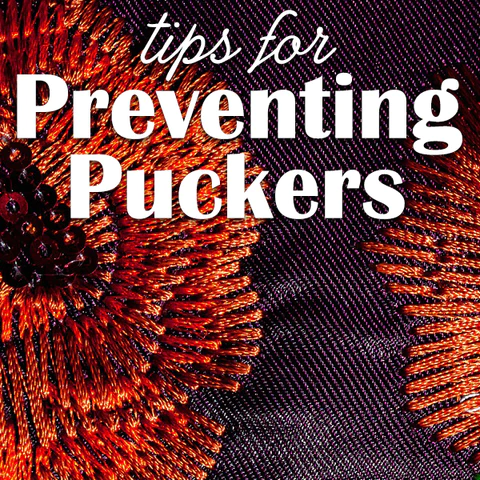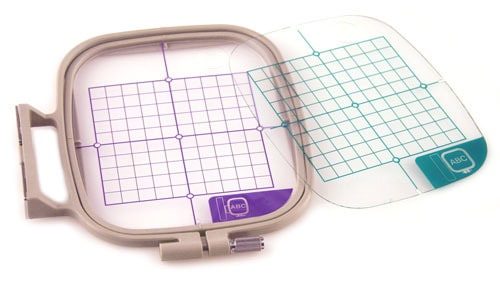Dealing with Jump Threads
Always trim jump threads before removing the project from the ring (A). Use arching embroidery scissors to simply clip getting ready to the jump thread. On the embroidery right aspect, clip as getting ready to the handicraft and cloth as attainable.
It’s not necessary to trim jump threads on the planning wrong aspect. If desired, trim threads ¼” from the finished embroidery style (B). Clipping too getting ready to the planning will cut the lock stitches, that causes the handicraft to unravel.
Once the jump threads square measure clipped, take away the material and stabilizer from the ring. perpetually unscrew the ring screw once removing {the cloth|the material}; forcing or pop the inner ring from the outer ring will cause friction burns on the fabric.
Removing Stabilizer
Remove excess cut-away stabilizer with scissors. once removing the project from the ring, place the project right facet au fait a flat surface. Gently separate the material from the stabilizer, and trim the stabilizer some ¼” from the embroidery perimeter, following the material drape . Don’t trim the stabilizer from each tight corner of the embroidery design; doing thus prevents the look from draping with the material. merely cut away a typically rounded form round the entire style .
How to take away cut-away or tear-away stabilizer
When removing tear-away stabilizer, continually support the stitches with one hand whereas tearing away with the opposite . This prevents the tearing method from distorting the look stitches. like cut-away, it’s not necessary to get rid of the stabilizer from each a part of the look. merely take away the bulk of the stabilizer from the look perimeter. Tear-away stabilizer is simple to get rid of once some washings.
How to take away wash-away stabilizer
Specialty stabilizers, like pressure-sensitive adhesives or water-activated adhesives, need further care throughout removal. For pressure-sensitive adhesive stabilizers, separate the adhesive from the material the maximum amount as doable before tearing or cutting away the surplus. For water-activated adhesives, continually re-moisten the stabilizer to loosen it from the material before removing the surplus .
To remove soluble topping from a project, remove the surplus from the look perimeter, then use a clean, wet artefact to dab away any little remaining items . It’s typically not necessary to clean or rinse Associate in Nursing item once victimisation soluble stabilizer as a topping solely.
Some comes require solely soluble stabilizer, like free-standing lace comes, in-the-hoop comes or comes with sheer materials. to get rid of soluble stabilizer, take away the bulk of the stabilizer to ¼” of the look before removal or laundry. For film stabilizers, remove the surplus, and for mesh soluble stabilizers, cut away the surplus inside ¼” of the look.
The fastest and most complete technique to get rid of soluble stabilizer is to rinse the look beneath heat running water . different choices embody soaking the item during a bowl of heat water or in some cases, washing the project. the correct stabilizer quantity to get rid of depends on the look. Free-standing lace needs removal till the stabilizer appears to disappear (but going away a number of the stabilizer to assist stiffen the lace). Sheer materials need removal the stabilizer away till you’ll not feel it within the cloth. Wet soluble stabilizer features a sticky, tacky feel till it’s utterly rinsed away.
Some styles need the stabilizer to stay within the project. For appliqué styles with giant open areas, going away the stabilizer beneath the look helps the appliqué look crisp and new for a extended amount of your time . If the project could be a quilt block or a handbag panel, leave the stabilizer sheet behind the complete cloth section and permit it to operate as Associate in Nursing interfacing.
Embroidery finishing touches
Add a bit of sentimental melted stabilizer as a lining over the look wrong facet to forestall it from rubbing the skin. Cut a rounded piece of melted stabilizer larger than the look and excess stabilizer perimeter, and fuse to the material wrong facet
Pressing Techniques
One of the foremost vital techniques for making professional-looking embroidery is pressing. continually press from the incorrect facet. Pressing from the proper facet will crush or soften the planning stitches and make planar shiny spots.
Place the embroidery wrong facet up over a downlike towel once pressing. The towel provides the embroidery stitches an area to sink into throughout pressing, permitting the encompassing material to press flat while not crushing the stitches.
Use solely clear starch for pressing embroidery to stop shiny spots and flaking on the planning.
Washing Your Embroidery Project
If the project material is washing-machine safe, sometimes the embroidery project is safe to scrub additionally. Some embroidery threads ar even bleach and fade resistant. take care to see with the thread manufacturer before wash any style.
Always use cut-away stabilizer on stretch materials that may be laundered. throughout the laundry method, the material stretches out of form. If the planning stitches aren’t supported by a permanent cut-away stabilizer, they will break or pop from the stretching.
Turn the project wrong facet out throughout laundry to stop the planning stitches from snags and friction from different clothes within the wash. once laundry and drying, press the embroidery to revive it to its skilled end.
Do you have some embroidery finishing touches to share? Leave them within the comments!
Related Posts
Discover relevant articles, tutorials, and tips to improve your skills and explore new techniques.
Stay inspired and connected to our embroidery community.







Hi, every time i used to check web site posts here early in the break
of day, for the reason that i like to find out more and more.
Hello my friend! I want to say that this article is awesome, nice written and include almost all significant infos.
I would like to peer more posts like this .
Hello, just wanted to say, I enjoyed this post.
It was practical. Keep on posting!
It’s wonderful that you are getting ideas from this post
as well as from our dialogue made here.